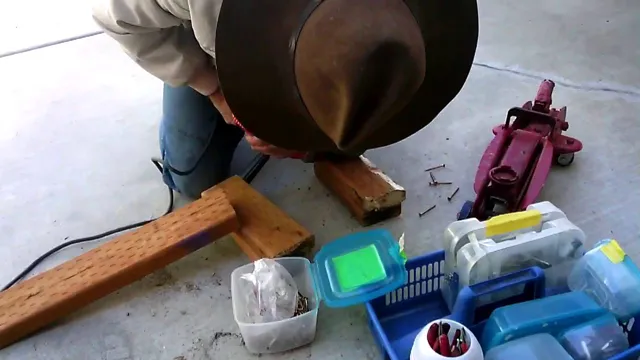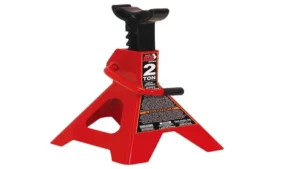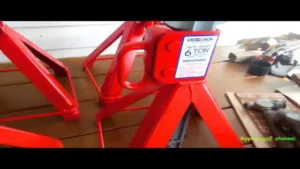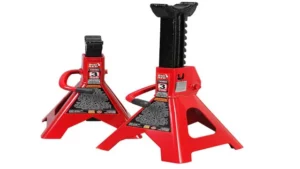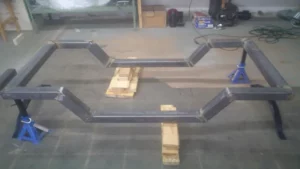Are you a DIY enthusiast looking to save some bucks and create your own equipment? If so, you might find building your own jack stands to be a fun project, not to mention that it’s a great way to learn about welding and metalworking. With these DIY jack stands, you’ll not only be able to work on your car but have complete control over their design and durability. If you’re unsure where to start, don’t worry! In this informative guide, we’ll take you through everything you need to know about building your jack stands.
From the materials you’ll need to the step-by-step instructions, we’ve got you covered. Imagine having your very own lightweight, durable, and versatile jack stand designed specifically to fit your car. You wouldn’t have to rely on costly pre-built products that might not even fit your vehicle correctly.
Plus, building your own jack stands is a great way to engage in creative problem-solving and testing out new skills. So why not put your DIY skills to the test and start building your own jack stands? Not only will you learn and challenge yourself, but you’ll also have a practical and useful piece of equipment to use for years to come.
Introduction
If you’re looking to build your own jack stands, it’s important to know which materials to use and how to use them properly. Jack stands are a useful tool for any mechanic or DIY enthusiast, and they can be built relatively easily with some basic tools and materials. The first step is to decide on the height and weight capacity that you need for your jack stands.
Once you have this information, you can begin to source the materials you’ll need, such as metal tubing and angle iron. With some careful cutting and welding, you can create a sturdy and reliable set of jack stands that will provide the support you need when working on your vehicle. It’s important to take your time and follow all safety precautions while building your jack stands, as well as maintaining them properly once they’re built.
With a little bit of know-how and some elbow grease, you can have a set of custom jack stands that will last you for years to come.
What are Jack Stands?
Jack stands are essential tools for any car owner or mechanic. They are commonly used to support a vehicle after it has been raised using a hydraulic jack. Jack stands are designed to hold the weight of a car and keep it stable while it is being worked on.
They are an essential part of any automotive repair or maintenance job and can help prevent accidents or injuries. By using jack stands, you can ensure the safety of yourself and others while performing tasks like changing tires, replacing brake pads, or inspecting the underside of a car. Always make sure to place the jack stands on a flat surface and use them in pairs to ensure maximum stability.
Overall, investing in a good pair of jack stands can make working on your car a lot safer and more comfortable.
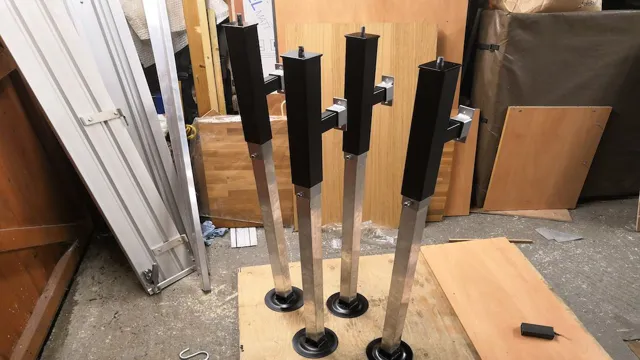
Why Build Your Own Jack Stands?
If you’re a DIY enthusiast, building your own jack stands can be a great way to add some personalized flair to your garage or workshop. Not only that, but creating your own jack stands gives you complete control over the materials, design, and overall quality of your final product. Plus, it can be a fun and rewarding project that allows you to flex your creative muscles.
By using high-quality materials and following proper safety guidelines, you can create a set of jack stands that will last for years to come. So why settle for mass-produced jack stands when you can build your own? Get started today and see the difference that customization can make.
Materials and Tools
When building a pair of jack stands, it’s important to use high-quality materials and reliable tools. You’ll need a sturdy base material, such as thick steel tubing or strong metal bars, to ensure your jack stands can support the weight of your vehicle. Additionally, you’ll want to invest in a high-quality welder to ensure your stands are secure and reliable.
A cutting torch or saw may also be necessary to shape and cut your steel tubing or metal bars. When it comes to safety, don’t skimp on the materials or tools you use. Cutting corners could result in a dangerous situation and increase the risk of injury or damage to your vehicle.
With the right materials and tools, building a pair of jack stands can be a straightforward and rewarding DIY project.
List of Tools Required
If you’re planning to work on a DIY project, it’s essential to have the right materials and tools to ensure a successful outcome. When it comes to tools, there are some basic items you should have on hand. A hammer, screwdrivers, pliers, and a level are some of the most important tools to have in your toolkit.
You’ll also want to have a measuring tape, a utility knife, and a power drill, as these will come in handy during various DIY projects. Additionally, you may need a saw, a sander, or a jigsaw depending on the project you’re working on. As for materials, this will vary depending on the project, but some common items include lumber, nails, screws, sandpaper, and paint.
With the right tools and materials, you can tackle just about any DIY project with confidence!
List of Materials Required
When it comes to DIY projects, having the right materials and tools is essential. For this particular project, you will need a few basic tools such as a hammer, screwdriver, drill and measuring tape. You will also need materials like wood planks, brackets, screws, sandpaper, and wood glue.
It’s important to make sure that the wood planks are of good quality and are thick enough to support the weight of the items you plan to place on the shelf. Brackets, screws, and wood glue are also important for securing the planks in place and ensuring that the shelf is sturdy. Sandpaper is also necessary to smooth out any rough edges or surfaces on the wood.
Overall, having all the necessary materials and tools is crucial for creating a strong and functional shelf that will last for years to come.
Steps to Build Jack Stands
If you are looking for a budget-friendly option to lift your vehicle for maintenance tasks, building your own jack stands can be a great solution. The process is quite simple and can be completed within a few hours using readily available supplies. To get started, you will need a set of jack stands, a metal or wooden base, and a few other tools like a saw and drill.
The first step is to design and cut out the base, ensuring it’s sturdy and large enough to support the weight of your vehicle. Next, drill holes on the base for each of the jack stands and attach them using nuts and bolts. Once assembled, test the jack stands with a load of similar weight to your vehicle before using them for lifting purposes.
With proper care and maintenance, your homemade jack stands can last for years, giving you peace of mind when working on your vehicle. So, what are you waiting for? Try building your own jack stands today and take advantage of a cost-effective and convenient way to keep your vehicle in tip-top shape.
Step One: Cutting the Steel Tubes
When starting the process of building your own jack stands, the first step is cutting the steel tubes. It’s important to have the right tools for this task, including a metal cutting saw and a measuring tape. Before beginning, mark the tubes with a permanent marker at the desired lengths to ensure accuracy.
Slowly and carefully guide the saw along the marked lines to cut the tubes to the correct size. Remember to wear protective gear, such as gloves and eye protection, to prevent injury and make sure to smooth out any rough edges with a metal file. Cutting the steel tubes may seem like a simple task, but it’s an important first step in building safe and sturdy jack stands.
Step Two: Drilling Holes in the Tubes
After cutting the steel tubes for your DIY jack stands, the next step is to drill holes in them. This is a crucial process as it will allow you to adjust the height of your stands based on your needs. To ensure that the holes are aligned, it is recommended to use a drill press.
Make sure to secure the tube in place and use a vice grip to hold it steady. Begin drilling the holes, starting with a smaller drill bit and gradually increasing the size until you reach the desired diameter. Remember to wear protective gear such as gloves and safety goggles, and work in a well-ventilated area.
Once the holes are drilled, round the edges with sandpaper to prevent any sharp edges from damaging the car. Following this step will ensure that your DIY jack stands are safe and reliable for use.
Step Three: Welding the Tubes and Plates Together
After measuring and cutting the metal tubes and plates for your jack stands, it’s time for the next step: welding them together. This is where things can get a little tricky if you don’t have much experience with welding. First, make sure you have all the necessary safety gear, including gloves and a welding helmet.
Then, begin to tack weld the plates to the tubes in the desired positions. Take your time to ensure that each weld is secure and strong. Once all the plates are tacked in place, you can begin to weld them fully by laying a continuous bead along the entire length of the joint.
Remember to move the welder slowly to avoid overheating or warping the metal. Welding is an excellent skill to have, but it’s essential to practice safety and take the time to do it correctly. By following these steps, you’ll have secure and sturdy jack stands that you can trust to keep your vehicle safely elevated.
Step Four: Testing the Jack Stands
Now that you’ve built your jack stands, it’s important to test them thoroughly to ensure they’re safe and sturdy. Begin by inspecting all the welds and joints for any signs of cracking or damage. Then, place a vehicle on the stands and let it sit for several hours to test their weight capacity.
If you’re satisfied with their performance, go ahead and use them for your next DIY repair job. Remember to always position the stands on a level surface and use chocks to prevent any accidental rolling. Safety should always be your top priority, and taking the time to test your jack stands is an essential step in ensuring a successful repair job.
Safety Precautions
If you’re planning to build your own jack stands, safety should be your top priority. Jack stands are essential tools for lifting and supporting vehicles, but they can be dangerous if not used correctly. Here are some safety precautions to consider when building jack stands: First, choose the right materials.
Use high-quality steel or strong wood that can handle the weight of your vehicle. Make sure your stands are stable and durable enough to prevent collapse. Second, always use jack stands on a level surface.
Never lift your vehicle on a slope or uneven ground. Doing so can cause the jack stands to tip over, causing serious injury. Third, never work under a vehicle supported only by jack stands.
Always use additional safety measures such as wheel chocks or support blocks. Fourth, inspect your jack stands regularly to ensure they are in good condition. Check for rust, cracks, or other signs of wear that could lead to failure.
Lastly, follow the manufacturer’s instructions carefully. Every set of jack stands is different, and it’s important to understand how to use them properly. By following these safety precautions, you can ensure that your homemade jack stands are safe and effective.
Always prioritize safety when working on your vehicle, and never take shortcuts when it comes to your safety or the safety of others.
Wearing Protective Gear
Protective gear is essential when it comes to staying safe in various situations. Whether you’re working in construction, playing sports, or riding a bike, protective gear can help prevent injuries and keep you safe from harm. The most common protective gear includes helmets, goggles, gloves, and pads.
These items are specially designed to protect different parts of your body and are made from durable materials that can withstand impact and other types of damage. When choosing protective gear, it’s important to select items that fit properly and are appropriate for your activity. For instance, a bike helmet may not provide enough protection when playing contact sports.
By wearing the right protective gear, you can significantly reduce the risk of injury and stay safe while enjoying your activities.
Storing and Maintaining Jack Stands
When it comes to using jack stands, safety is the top priority. But what about storing and maintaining them? It’s important to keep your jack stands in good condition, especially if you want to rely on them to keep you safe while working on your vehicle. When choosing a location to store them, make sure they are in a dry place, away from any moisture that could cause corrosion.
You’ll also want to keep them off the ground, using a shelf or storage rack to prevent damage to the stand. Regular maintenance is also necessary to keep your jack stands functioning properly. Always inspect them before each use, checking for any cracks or signs of wear.
Make sure the locking mechanisms are working correctly and the weight capacity is appropriate for the vehicle you’ll be working on. Taking these safety precautions will ensure that your jack stands will be ready to use when you need them most.
Conclusion
In conclusion, building your own jack stands is a fun and rewarding project that not only saves you money but also gives you the satisfaction of completing a DIY task. With the right tools, materials, and a bit of patience, you can craft your own stands that rival those sold at auto shops. So why settle for store-bought jack stands when you can create your own personalized and unique set? Plus, if you ever find yourself stranded on the side of the road, your homemade jack stands will have your back.
Happy building!”
FAQs
What materials do I need to build jack stands?
To build jack stands, you will need steel tubing, angle iron, bolts, nuts, and welding equipment.
Can I use wood instead of steel to build jack stands?
While it is possible to use wood to build jack stands, it is not recommended as it may not be able to support the weight of a vehicle.
What is the weight capacity of homemade jack stands?
The weight capacity of homemade jack stands varies depending on the materials used and the design. It is recommended to test the jack stands before use.
Is it safe to use homemade jack stands?
Homemade jack stands can be safe to use if they are built properly and with the correct materials. However, it is important to use caution and only use them on a level and stable surface.
How tall should homemade jack stands be?
The height of homemade jack stands should be determined by the height of the vehicle being lifted. It is recommended to build them slightly taller than necessary for added stability.
Are there any safety guidelines I should follow when building jack stands?
Yes, it is important to wear protective gear when welding, use the correct materials and design for the weight of the vehicle, and test the jack stands before use.
Can I find plans or instructions for building jack stands online?
Yes, there are many websites and resources available online that provide plans and instructions for building jack stands. It is important to choose a reputable source and follow the instructions carefully.
